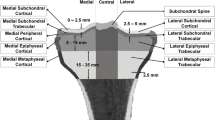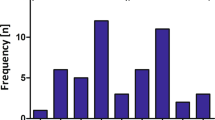Abstract
Objective
The purpose of this study was to evaluate strain ratio measurement of femoral cartilage using real-time elastosonography.
Methods
Twenty-five patients with femoral cartilage pathology on MRI (study group) were prospectively compared with 25 subjects with normal findings on MRI (control group) using real-time elastosonography. Strain ratio measurements of pathologic and normal cartilage were performed and compared, both within the study group and between the two groups.
Results
Elastosonography colour-scale coding showed a colour change from blue to red in pathologic cartilage and only blue colour-coding in normal cartilage. In the study group, the median strain ratio was higher in pathologic cartilage areas compared to normal areas (median, 1.49 [interquartile range, 0.80–2.53] vs. median, 0.01 [interquartile range, 0.01–0.01], p < 0.001, respectively). The median strain ratio of the control group was 0.01 (interquartile range, 0.01–0.01), and there was no significant difference compared to normal areas of the study group. There was, however, a significant difference between the control group cartilage and pathologic cartilage of the study group (p < 0.001).
Conclusions
Elastosonography may be an effective, easily accessible, and relatively simple tool to demonstrate pathologic cartilage and to differentiate it from normal cartilage in the absence of advanced imaging facility such as MRI.
Key Points
• Elastosonography uses colour-maps and strain ratios for evaluating tissue deformability.
• Colour change from blue to red and increased strain ratio represent softening.
• Normal cartilage shows decreased compressibility, represented by blue colour and low strain ratio.
• Pathologic cartilage shows increased compressibility, represented by red colour and high strain ratio.
• Elastosonography may be used for differentiating pathologic cartilage from normal cartilage.





Similar content being viewed by others
Abbreviations
- dGEMRIC:
-
Delayed gadolinium-enhanced MRI of cartilage
- DWI:
-
Diffusion-weighted imaging
- FOV:
-
Field of view
- MRI:
-
Magnetic resonance imaging
- PACS:
-
Picture archiving and communication system
- PDW:
-
Proton density-weighted
- ROI:
-
Region of interest
- RTE:
-
Real-time elastosonography
- US:
-
Ultrasonography
References
Goyal N, Gupta M (2012) Computerized morphometric analysis of human femoral articular cartilage. ISRN Rheumatol 2012:360201
Lee CL, Huang MH, Chai CY, Chen CH, Su JY, Tien YC (2008) The validity of in vivo ultrasonographic grading of osteoarthritic femoral condylar cartilage: a comparison with in vitro ultrasonographic and histologic gradings. Osteoarthr Cartil 16:352–358
Moller I, Bong D, Naredo E et al (2008) Ultrasound in the study and monitoring of osteoarthritis. Osteoarthr Cartil 16(Suppl 3):S4–7
Yoon CH, Kim HS, Ju JH, Jee WH, Park SH, Kim HY (2008) Validity of the sonographic longitudinal sagittal image for assessment of the cartilage thickness in the knee osteoarthritis. Clin Rheumatol 27:1507–1516
Castriota-Scanderbeg A, De Micheli V, Scarale MG, Bonetti MG, Cammisa M (1996) Precision of sonographic measurement of articular cartilage: inter- and intraobserver analysis. Skelet Radiol 25:545–549
Mathiesen O, Konradsen L, Torp-Pedersen S, Jorgensen U (2004) Ultrasonography and articular cartilage defects in the knee: an in vitro evaluation of the accuracy of cartilage thickness and defect size assessment. Knee Surg Sports Traumatol Arthrosc 12:440–443
Kara M, Tiftik T, Oken O, Akkaya N, Tunc H, Ozcakar L (2013) Ultrasonographic measurement of femoral cartilage thickness in patients with spinal cord injury. J Rehabil Med 45:145–148
Frey H (2003) Realtime elastography. A new ultrasound procedure for the reconstruction of tissue elasticity. Radiologe 43:850–855
Ophir J, Cespedes I, Ponnekanti H, Yazdi Y, Li X (1991) Elastography: a quantitative method for imaging the elasticity of biological tissues. Ultrason Imaging 13:111–134
De Zordo T, Lill SR, Fink C et al (2009) Real-time sonoelastography of lateral epicondylitis: comparison of findings between patients and healthy volunteers. AJR Am J Roentgenol 193:180–185
De Zordo T, Fink C, Feuchtner GM, Smekal V, Reindl M, Klauser AS (2009) Real-time sonoelastography findings in healthy Achilles tendons. AJR Am J Roentgenol 193:W134–138
Tan S, Kudas S, Ozcan AS et al (2012) Real-time sonoelastography of the Achilles tendon: pattern description in healthy subjects and patients with surgically repaired complete ruptures. Skelet Radiol 41:1067–1072
Cho N, Jang M, Lyou CY, Park JS, Choi HY, Moon WK (2012) Distinguishing benign from malignant masses at breast US: combined US elastography and color Doppler US—influence on radiologist accuracy. Radiology 262:80–90
Matzat SJ, van Tiel J, Gold GE, Oei EH (2013) Quantitative MRI techniques of cartilage composition. Quant Imaging Med Surg 3:162–174
Newbould RD, Miller SR, Upadhyay N et al (2013) T1-weighted sodium MRI of the articulator cartilage in osteoarthritis: a cross sectional and longitudinal study. PLoS One 8:e73067
Park GY, Kwon DR (2011) Application of real-time sonoelastography in musculoskeletal diseases related to physical medicine and rehabilitation. Am J Phys Med Rehabil 90:875–886
Tan S, Ozcan MF, Tezcan F et al (2013) Real-time elastography for distinguishing angiomyolipoma from renal cell carcinoma: preliminary observations. AJR Am J Roentgenol 200:W369–375
Alam F, Naito K, Horiguchi J, Fukuda H, Tachikake T, Ito K (2008) Accuracy of sonographic elastography in the differential diagnosis of enlarged cervical lymph nodes: comparison with conventional B-mode sonography. AJR Am J Roentgenol 191:604–610
Lyshchik A, Higashi T, Asato R et al (2005) Thyroid gland tumor diagnosis at US elastography. Radiology 237:202–211
Tunc H, Oken O, Kara M et al (2012) Ultrasonographic measurement of the femoral cartilage thickness in hemiparetic patients after stroke. Int J Rehabil Res 35:203–207
Kaya A, Kara M, Tiftik T et al (2013) Ultrasonographic evaluation of the femoral cartilage thickness in patients with systemic lupus erythematosus. Rheumatol Int 33:899–901
Tatar IG, Kurt A, Yilmaz KB, Akinci M, Kulacoglu H, Hekimoglu B (2013) The learning curve of real time elastosonography: a preliminary study conducted for the assessment of malignancy risk in thyroid nodules. Med Ultrason 15:278–284
Acknowledgements
The scientific guarantor of this publication is Prof. Halil Arslan. The authors of this manuscript declare no relationships with any companies whose products or services may be related to the subject matter of the article. The authors state that this work has not received any funding. Dr. Serkan Cay (Yuksek Ihtisas Heart Education and Research Hospital, Ankara, Turkey) kindly provided statistical advice for this manuscript. Institutional Review Board approval was obtained. Written informed consent was obtained from all patients in this study. Methodology: prospective case-control study, performed at one institution.
Author information
Authors and Affiliations
Corresponding author
Rights and permissions
About this article
Cite this article
Cay, N., Ipek, A., Isik, C. et al. Strain ratio measurement of femoral cartilage by real-time elastosonography: preliminary results. Eur Radiol 25, 987–993 (2015). https://doi.org/10.1007/s00330-014-3497-y
Received:
Revised:
Accepted:
Published:
Issue Date:
DOI: https://doi.org/10.1007/s00330-014-3497-y




